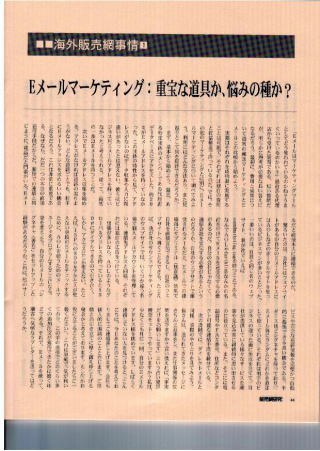Email Marketing: Boon or Bane?
 Jack Burke |
I recently received an e-mail from an insurance producer asking, "How is e-mail being used as a marketing tool? Is it successful?" Now there's a short question with a potentially long answer that definitely got me thinking. In fact, I initially started writing about cost and result comparisons between regular mail marketing versus e-mail.
However, the reality is that each can be successfully implemented in its own right with its own unique cost and return variables. So let's look at e-mail independent of any other type of marketing. What are some of the ways you can utilize it and what might you expect in return?
Let's start with the basics. I recently had access to a database of agencies that were members of a singular group. Approximately 20% did not have e-mail addresses listed. Due to the unique nature of this group, I don't believe the lack of addresses was a failure to collect and input the data. I believe these people did not have business e-mail addresses. So the first step is to have e-mail.
Then begin collecting e-mail addresses. If you don't have them, you can't contact them. Every contact should be an opportunity to ask for their e-mail. This is critical, because it is the only true, direct line of communication that exists. Telephones have gate keepers, as does mail call. E-mail goes direct to the source.
A factor which I find surprising relates to the number of people in business that have a company web site, yet utilize AOL and other such portals for their e-mail address.
Ideally you have a web site that is based on your name, ours is "soundmarketing.com" - the same name as the company. Why would I want to send and receive e-mail under the name of AOL or Earthlink? Why would I want to advertise them, as opposed to my own company? As subliminal as it may be, every e-mail correspondence where the mail is managed through your own web site is direct advertising for your company--and the directions to your web site. For instance, through our Sound Marketing web site I manage personal mail accounts under several different names. Each is its own advertisement, as well as a contact address.
If you travel a lot, it may pay to have a worldwide access address like AOL where you can dial into an 800#. But use it only for access. Program the mail manager to use AOL, for example, to check your regular e-mail accounts that might not have 800# access to the ISP.
Moving on, have you set up "signatures" for your e-mail? This is a perfect and automatic opportunity to mention other services and provide complete contact information. I use about half a dozen and set them up to be added to by e-mails on a random basis. Each one concentrates on a different facet of your business and serve as continual reminders to our clients and prospects about the varied services we offer. They also provide phone numbers, fax #s and snail mail addresses for contact by any means possible.
The next step, as in direct mail, is to look at your actual correspondence. Do you strictly reply to messages sent and send business-related questions? In other words, do you operate under the old Dragnet motto, "Just the facts, please."? At least once per month, I like to browse through my e-mail address book. When I see someone I haven't corresponded with in a while, I send them a cheery little note: "Hi, just wanted to let you know that I was thinking about you today. Hope all goes well with both your business and personal lives, and I thought it was time to let you know how much we appreciate your friendship and your business. If you need anything, give me a call." It's simple and thoughtful, and it's amazing how much extra business those types of notes generate. So use your e-mail to send an occasional love letter to your clients.
As we become more advanced, think in terms of regularly scheduled newsletters to your clients, friends and prospects. They can be as fancy, or as simple, as you choose. Many major entities present their newsletters in simple text. Others utilize HTML language and make them as fancy as a web site. The format is far less critical than the content. If you send one, make sure the information is valuable and appreciated.
The best example I can cite of newsletter effectiveness is ProgramBusiness.com. It has been my privilege to serve as editor of ProgramBusinessNews, which is published every 10 days. In six short months the ProgramBusiness web site is already approaching a million hits per month. The only marketing tool driving this company is the newsletter. Not a penny has been spent on advertising to this point. Newsletters work, they really do!
Proceeding from these common sense basics, it's time to talk about "broadcast" or "bulk" e-mail. Here we find a lot of mixed emotions, so let's establish some guidelines.
Make sure there is value to the recipient.
Give to get! A pure
commercial is more likely to be immediately trashed than a message that first
provides something of interest and value to the recipient. Some free advice on a
risk management or business issue at the opening may predispose the recipient to
read the entire message and possible take action.
Gain their permission in advance.
Permission marketing may be a
popular buzzword, but don't sell it short. Sending to a "permission list" will
garner far better results than sending to a "cold list". Granted there's some
value to both, but as a salesperson you already know that you're far better off
making a sales call by appointment, than by making a cold call. The same applies
to e-mail marketing.
Avoid attachments.
Due to the very real virus dangers, many
people are afraid of e-mail attachments and immediately trash them. Plus, many
corporate e-mail management systems will not process through an e-mail with an
attachment. Keep it simple with a text message.
Utilize hyperlinks.
As opposed to attachments, it is very easy to
insert hyperlinks to your web site or even a particular page within your web
site. Most e-mail software automatically converts such addresses to hyperlinks
without any direct action on your part. Keep the text message concise, but
direct them to your web site for specific actions. For instance, I recently sent
a broadcast e-mail about my new book Relationship Aspect Marketing. The only
action suggested in the e-mail text was to hyperlink to for more information
Hyperlinks are also an excellent way to bring added value. You might include a
short quotation from an informative article, then offer a hyperlink to the
complete article if they'd like more detail.
Make it as personal as possible.
Remember this is an electronic
letter. The more personal the writing, the greater the likelihood that people
will read it. As mentioned earlier, this mail goes direct to the recipient.
Secretaries and telephone receptionists are not blocking the way.
Make it look good.
E-mail software today is far more innovative
than just a few years ago. Take advantage of the ability to select fonts, sizes,
underlining, bolding and italicizing. This adds texture to your message and
increases readability. You can even get into background and type colors, pasting
pictures and animation. However don't go overboard and create such a large
document that it takes a lot of time to load. Remember, a lot of your recipients
are still on dial-up modems.
Set reasonable expectations.
In regular direct mail campaigns,
experts suggest that you should expect a 2-3% return. Sometimes you get lucky
and get more, sometimes you get less. But 2-3% has always served as a good
guideline for "cold" direct marketing. Don't expect that type of return with
e-mail. My experience has been that 0.03-0.05% is a fair return. Granted you may
get lucky and do far better --particularly with a warm, permission-based list or
with a broadcast to existing clients who already do business with you.
Electronic mail does not have the same intrinsic values associated with real
paper. It's definitely less expensive, but don't expect the same results as with
direct mail.
As with any new technology, take some to get acquainted with the potential. Begin slowly and increase your activity as you gain experience and knowledge. "Dot-coms" may be experiencing difficulties today, but the Internet is here to stay. Make it your friend.
Jack Burke is the president of Sound Marketing, Inc., host/producer of Audio Insurance Outlook, editor of ProgramBusiness.com newsletter, and author of both Relationship Aspect Marketing and Creating Customer Connections. For more information, please visit http://www.soundmarketing.com/, call 1-800-451-8273, or e-mail jack@soundmarketing.com.
ジャック・バーク
サウンドマーケティング社長
「Eメールはマーケティングツールとしてどう使われているのかね?うまくいっているのかい?」最近ある代理店からEメールで受けた質問である。短い質問だが、明らかに熟考が必要な長い答えになるだろう。最初に、費用と成果について通常の郵送マーケティングとEメールとの比較から始めよう。
だが、実際はそれぞれを成功裏に実施することは可能で、それぞれは独自の費用と収益構造で持っているのだ。それでは、その他のマーケティングとは別に、Eメールマーケティングについて調べてみよう。利用にはどんな方法あり、また見返りとして何を期待できるだろうか。
まず、基本から始めよう。最近、ある特定団体のメンバーである代理店データベースにアクセスした。約20%がEメールアドレスを持っていなかった。この団体の特異性から見て、アドレスがないのはデータ収集や入力に間違いがあったとは思えない。彼らはビジネス用Eメールアドレスを持っていなかったと考えられる。従って、最初の一歩はEメールを持つことだ。
次いでEメールアドレス収集を始める。アドレスがなければ連絡の取りようがない。どんな連絡ごとでも、相手にEメールアドレスを求めるいい機会となるだろう。これは非常に重要である。なぜなら、だだ一つの本当の直接通信手段が存在するからだ。郵便での連絡と同じように、電話だと門番がいる。Eメールだと直接本人に連絡できるのだ。
驚きの発見の一つに、会社にはウェブサイトがあるが自分のEメールアドレスにはAOLなどのポータルサイトを使っているビジネスマンの数の多さがあった。一番いいのは、自社と同じ名のウェブサイト、我が社でいえばsoundmarketing.comを持つことである。なんでAOLやEarthlinkなんかの名前を付けてEメールを送受信する必要があるのだ。自分の会社じゃなくて、そいつらを宣伝する必要があるというのか。自社のウェブサイトで運営されるメールだと、Eメールでの連絡毎にサブリミナル(無意識)効果で自社を直接宣伝できるし、自社のウェブサイトへ導くこともできる。たとえば、我が社のサウンドマーケティングのウェブサイトでは、いくつか違う名前で個人メールアカウントを管理している。連絡先アドレスと同様、それぞれには独自の広告をつけている。
出張が多いなら、AOLのようなグローバルアドレスを持っていると800#にダイアルできるので引き合う。しかし、アクセスにしか使えない。たとえば、ISPへの800#アクセスが使えない普段のEメールをチェックするために、AOLを使うためのメールマネージャをプログラムすることになる。
話を変えよう。自分のEメールの「シグネチャ(署名)」をセットアップした経験があるか。これは、他のサービスや完全な連絡情報を完璧かつ自動的に提供できる良い機会である。半ダースほどシグネチャを持っており、Eメール毎にランダムにどれかを追加して使っている。それぞれは相手のビジネスの違った面に焦点を当てて、自社が提供している様々なサービスを顧客や見込み客に継続的に思い出させるのに役立っている。また、そこには電話番号やFax番号、住所などコンタクト可能な連絡手段を載せている。
次の段階は、ダイレクトメールと同様、実際のやりとりを見てみよう。皆さんは、送られてきたメッセージにきちんと返事をし、また仕事関係の質問を送りますか?言い換えれば、「事実だけをお願いします」という古い犯罪捜査モットーでやっていますか?私は、少なくとも月に1回、自分のEメールアドレス帳を眺めています。しばらく連絡していない人を見つけると、「こんにちは、今日あなたのことを考えておりましてご連絡差し上げます。会社も個人的にもうまくいっているものと存じます。ご厚情とお引き立てに厚く御礼申し上げる機会かと考えております。もし何か必要なことがございましたらご一報ください(こんにちは、ご無沙汰しておりますがお変わりございませんか。平素よりお引き立てを頂き厚く御礼申し上げます。もし、私どもで何かお手伝いできることがございましたら、是非ご一報ください)」。これは単純で、気が利いており、この手の挨拶でどのくらい多くの追加注文が獲得できたかは驚くほどである。それで、Eメールを使って、顧客へ気軽なラブレターを送ってはどうだろうか。
もう少し上達したら、顧客や見込み客、友人たちにに定期ニューズレターを送ることを考えよう。しゃれたものでも、単純なものでも好きな内容を選んでいい。多くの組織では単純なテキストでニューズレターを出している。HTML言語を使って、ウェブサイトのように見栄え良くしているものもある。形式はその内容に比べるとほとんど重要でない。1通送れば、その情報が価値があり、好評だったかどうか確認しなさい。
効果的なニューズレターで一番いい例をあげるとすればProgramBusiness.comである。プログラムビジネスニューズの編集者を勤めているのは名誉なことだが、このニューズレターは10日ごとに発行されている。半年足らずの内にプログラムビジネスニューズのウェブサイトは毎月100万件アクセスされるようになった。このニューズレターがこの会社を前進させている唯一のマーケティングツールなのだ。この点について、広告に1円も使われてこなかった。ニューズレターは効果があり、実際にそうなのだ。
こうした常識ベースの話を進めて、「ブロードキャスト(放送)」や「バルク(大量)」Eメールについて語をしよう。これについてはかなり混乱しているので、ガイドラインを設定しよう。
受け手に有益であることを確認する
与えてから得よ。受け手にとって興味あることや価値あることを最初に提供するメッセージに比べて、純然たるコマーシャルはただちにゴミ箱行きになりやすい。冒頭にリスクマネージメントやビジネス問題について無料アドバイスを載せると、受け手はメッセージ全体を読む気になるし、何か行動を起こすかもしれない。
事前に承諾を得る
承諾マーケティングは一種のはやり言葉であるが、軽く見てはいけない。「承諾リスト」へ送るほうが「(関係が成り立っていない)コールドリスト」に送るよりいい結果を得ることができる。どちらもある程度価値があるが、営業マンなら、飛び込み訪問よりアポを取った上で訪問するぼうがずっといいことを知っている。Eメールマーケティングでも同じことがいえる。
添付をつけない
ウィルスの危険のため、Eメールの添付物をいやがる人が多く、(添付メールは)直ちにゴミ箱行きになる。また、企業のEメール管理システムは添付物の付いたEメールを扱わない。テキストメッセージだけの簡単なものにすべきである。
ハイパーリンクを使う
添付物の代わりに、自社のウェブサイトまたはウェブサイトの特定ページにハイパーリンクを付けるのが簡単なやり方だ。ほとんどのEメールソフトは、自分の方で直接操作することなく、ウェブサイトのアドレスをハイパーリンクに自動変換してくれる。テキストメッセージを簡潔にしておいたまま、自社のウェブサイトに導いて、別な活動に誘うのである。たとえば、最近、「関係性のマーケティング」という自書についてブロードキャストEメールを送った。Eメールのテキストに書いたのは、詳しいことはハイパーリンクを参照するように推奨しただけだった。ハイパーリンクは付加価値を付けるのに優れた方法でもある。情報量の多い記事から手短に引用できるし、もっと詳しい内容が欲しいなら、全文のハイパーリンクを付けることができる
できるだけ私的にする
これは電子レターなのだ。私的な書き方をする方が、人は呼んでくれるようになる。前に言ったとおり、この手紙は直接受取手に届くのだ。秘書も電話交換手もじゃますることはないのである。
体裁を良くする
今日のEメールソフトは、ほんの数年前のものよりずっと革新的である。この能力を利用して、フォントやサイズ、下線、太字、イタリック体を選ぶことができる。メッセージに味わいを付ければ信頼性が増すというものだ。背景や文字の色、異動する画像や動画でさえ使うことできる。だが、受け手の多くはまだダイアルアップで接続していることを忘れないように。
妥当な期待値を設定する
一般のDMでは返信率は2〜3%だと専門家は指摘している。ある場合は運良くもっと高い返信率を得るし、またある時はそれより低い。だが、この2〜3%は「コールド」ダイレクトマーケティングのガイドラインとして有用である。私の経験では、返信率0.03〜0.05%がいいところだろう。友好的な承認リストを使うか、既に取引のある既存顧客にブロードキャスト(一斉同報)することで、うまく行ったり、更に良い結果が生まれるかもしれない。電子メールは、実際の紙が本来的に備えてい留のと同じ価値を持ち合わせていない。確かに電子メールは費用がかからないが、ダイレクトメールと同じ結果を期待できない。
他の新技術と同様、潜在能力まで精通するのは大変である。ゆっくりとしたペースで始め、経験と知識を積むに従って速度を上げるといい。ドットコムカンパニーは現在、試練を経験しているかもしれないが、インターネットは存在しているのだ。味方にして損はない。
著者について
ジャック・バークはサウンドマーケティング社の社長で、オーディオ・インシュランス・アウトルックの支配人兼制作者、ProgramBusiness.comニューズレターの編集者でもある。また、リレーションシップ・アスペクト・マーケティングとクリエイティブ・カストマー・コネクションの著者である。詳細は、http://www.soundmarketing.com、または電話1-800-451-8273, もしくは Eメールjack@soundmarketing.comまで。.

